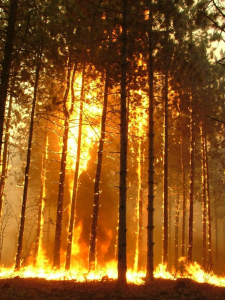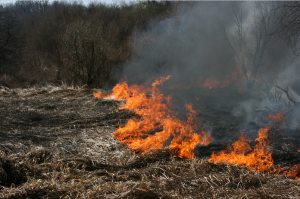 Fire danger in 2012 fire season in Hungary
Fire danger in 2012 fire season in Hungary
FWI derived data and values were reported throughout the whole fire season by Forestry Directorate (FD). FD has been using JRC’s data service to monitor the daily fire danger situation.
Forest fire hazard strongly depends on weather conditions. 2012 was the year of the highest extreme weather situations in the past 100 years. We may characterize the first nine months of 2012 with serious drought. The drought period lasted throughout whole summer and influenced the whole fire season.
Fire danger started to rise in April and it reached the “very high” level more times during the year. There were some short periods (days) when the FWI values reached the “extreme” level in summer. So a total fire ban was ordered two times and local or regional fire bans were ordered more than thirty times by the Forestry Directorates.
Although the fire dangerous periods were forecasted from April, there were lots of wildfires in the endangered parts of Hungary from the beginning of March. The 2012 fire season reached out to the autumn (mid of October).
Fire occurrences and affected surfaces
Forest fires data are collected in a strong cooperation with disaster management authority. Data collected on the spot by fire fighters are uploaded to the database weekly and if needed it can be done day-to-day. Forest fires data are prepared and analysed with an automated GIS method and checked on the spot by forest authority.
| Table 1. | ||||
| Year | Number of wildfires | Forest fires in Hungary | Wildfires in other land | |
| Number of fires | Total burned area (ha) | Number of fires | ||
| 2007 | 6.691 | 603 | 4.636 | 6088 |
| 2008 | 6.639 | 502 | 2.404 | 6137 |
| 2009 | 8.658 | 608 | 6.463 | 8050 |
| 2010 | 3.120 | 109 | 878 | 3011 |
| 2011* | 8.436 | 2.021 | 8.055 | 6415 |
| 2012 | 21.581 | 2.657 | 13.978 | 18.924 |
| *from 2011 Fire Database linking between Forestry Directorate and Fire Service | ||||
Forest fires have multiplied in the last few decades in Hungary. The reasons can be found in climate extremities, less precipitation, the increase of mean annual temperature and a series of winters without snowfall. Due to the warming, the dangerous period of wildfires have extended, which may issue in the increase of such fires, especially if the socio-economic circumstances remain the same. (Data from 2007 are shown above on Table 1.)
95% of forest fires are surface fires, as you can see down below in Table 2. Surface fires, when surface litter and other dead vegetal parts and smaller shrub burn have been common in Hungarian forests. They can develop in whole fire season. Canopy fires mostly develop in coniferous forests, mainly in the Great Hungarian Plain during summer. Ground fire is not significant in Hungary, though – due to partial, relatively thick peat – it is not unknown either.
| Table 2. | ||
| Type of forest fire | Number of fires | Total burnt area (ha) |
| Ground fires | 19 | 267 |
| Surface fires | 2.621 | 12.401 |
| Crown fires | 17 | 1.309 |
| Total | 2.657 | 13.977 |
The number of forest fires have significantly increased in the latest years. They spread to almost 50 hectares from time to time again. The average rate of fires smaller than 1 ha is almost 50 percent. The most problematic and the most prevalent type is the so called “average size” forest fire (between 1 ha and 10 ha), which adds up to the other 40 percent of the total number of fires. The average total burnt area was 5,3 hectares in 2012, which is significantly higher than in previous years. In 2012 there were 49 fires events when more than 50 hectares were burnt. In most cases about 30 percent of the total burnt area is forest.
Small fires under 1 hectare extent give 62 % of the total of forest fires. This fact well depicts well that the capacity of fire fighters and disaster prevention services are overloaded by spot fires. Small fires are usually low intensity surface fires where dry grass and small twigs are burning. There are forest fires beyond 100 hectares rarely in Hungary, in which mainly conifers, native poplars and locusts are burnt.
 In 2012 there were 27 fire events where more than 100 hectares were burnt.
In 2012 there were 27 fire events where more than 100 hectares were burnt.
Due to climate and vegetation circumstances, naturally induced forests fires are of no account (about 1%) in Hungary. 99 % of forest fires are human induced (negligence or arson). Most fires are induced by (adults’ and infants’) negligence and only a small proportion of fires are caused by arsonists. Typical forest fire causes are the incorrectly extinguished fires of hikers, and the illicit agricultural fires. Most part of the total burnt area was due to incorrectly extinguished fires.
There are a lot of fires with unknown causes. The cause of the fire is not verifiable directly in many cases. If the circumstances of the forest fires are undetermined, the cause is registered as “unknown”.
Spring vegetation fires usually burn with low or medium intensity in broadleaf forests, juvenile growths, shrubs and grasslands. Fire totally or partially consumes forests and causes serious harms. 40-45 % of spring fires burn in northern areas (Borsod-Abaúj-Zemplén County, Heves County, Nógrád County) which indicates these areas as high forest fire danger zones. In these areas not only traditional grassland management methods, but other social-economic factors add to forest fire danger.
Forest litter, needles, dead twigs and branches get totally dry in arid summer periods (June- August) without rainfall and start easily burning as a consequence of negligently lighted fire. Coniferous forests are highly endangered, as a small litter layer fire can even result in canopy fire in this period.
Unlike spring fires, summer fires usually burn in the Great Hungarian Plain. These fires burn almost every year in the poor sites of Bács-Kiskun county and Csongrád county. Usually they do not have as dramatic effects as in May 2012 when 1000 hectares burnt near Bugac village.

Bugac

